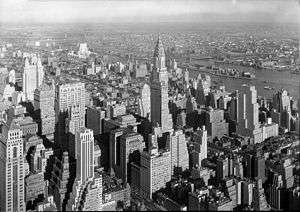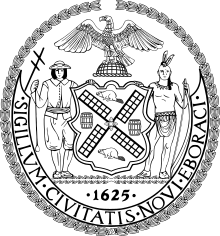1916 Zoning Resolution

The 1916 Zoning Resolution in New York City was the first citywide zoning code in the US. The zoning resolution reflected both borough and local interests, and was proposed after the development of 120 Broadway (the Equitable Building) in lower Manhattan. It was a measure adopted primarily to stop massive buildings from preventing light and air from reaching the streets below, and established limits in building massing at certain heights, usually interpreted as a series of setbacks and, while not imposing height limits, restricted towers to a percentage of the lot size. The chief authors of this resolution were George McAneny and Edward M. Bassett.[1]
Impact
The 1916 Zoning Resolution had a major impact on urban development in the US and internationally.[2] Architectural delineator Hugh Ferriss popularized these new regulations in 1922 through a series of massing studies, clearly depicting the possible forms and how to maximize building volumes. "By the end of the 1920s the setback skyscraper, originally built in response to a New York zoning code, became a style that caught on from Chicago to Shanghai," observe Eric Peter Nash and Norman McGrath,[3] discussing the Williamsburgh Savings Bank Building, which rose in isolation in Brooklyn, where no such zoning dictated form. The tiered Art Deco skyscrapers of the 1920s and 1930s are a direct result of this resolution.
Legacy
By mid-century most new International Style buildings had met the setback requirements by adopting the use of plazas or low-rise buildings surrounding a monolithic tower centered on the site. This approach was criticized.[4]
In 1961 the city reformed its zoning ordinance. The new zoning solution used the Floor Area Ratio (FAR) regulation instead of setback rules. A building’s maximum floor area is regulated according to the ratio that was imposed to the site where the building is located. Another feature of new zoning solution was adjacent public open space. If developers put adjacent public open space to their buildings, they could get additional area for their building as a bonus. This incentive bonus rule was created because of the strong influence from two representative skyscrapers. The Seagram building by Mies van der Rohe with Philip Johnson, and the Lever House by Skidmore, Owings & Merrill introduced the new ideas about office building with open space. These buildings changed the skyline of New York City with both the advent of simple glass box design and their treatment of adjacent open spaces. The new zoning encouraged privately owned public space to ease the density of the city.[5]
See also
References
- ↑ Dunlap, David W. (July 26, 2016). "Zoning Arrived 100 Years Ago. It Changed New York City Forever". The New York Times.
- ↑ "Background". www1.nyc.gov. Retrieved 2017-05-24.
- ↑ Nash and McGrath, Manhattan Skyscrapers 2005:55.
- ↑ Dunlap, David W. (December 7, 2006). "At New Trade Center, Seeking Lively (but Secure) Streets". The New York Times. Retrieved 2008-06-06.
- ↑ W. Bressi, Todd (1993). Planning and Zoning New York City. Rutgers, the State University of New Jersey. pp. 9–12.
Further reading
- Ferriss, Hugh. The Metropolis of Tomorrow, with essay by Carol Willis. New York: Princeton Architectural Press, 1986. Reprint of 1929 edition. ISBN 0-910413-11-8.
